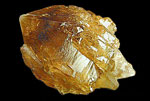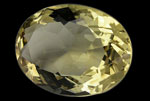Citrine - Mineral and Healing Properties


Chemistry: SiO 2
Class: Silicates
Subclass: Tectosilicates
Uses: Jewelry
CLICK HERE To Purchase Kidz Rocks Citrine Products.
-
 Citrine Druze
Citrine Druze -
 Citrine Polished
Citrine Polished -
 Citrine Crystal
Citrine Crystal -
 Faceted Citrine
Faceted Citrine
Citrine is any quartz crystal or cluster that is yellow or orange in color. Although often cut as a gemstone, citrine is actually somewhat rare in nature. Much of the natural citrine may have started out as amethyst but heat from nearby magmatic bodies may have caused the change to citrine.
Citrine made by heating amethyst may be returned to a purple color by bombarding it with beta radiation. Interestingly, a popular gemstone on the market is a mixture of half amethyst and half citrine and is given the name Ametrine, made by heating an amethyst until it turns into citrine, then irradiating a part of the resulting crystal or gemstone to convert that portion back to amethyst.
Unfortunately for citrine it is often confused with the more expensive orange-yellow topaz and is at times sold as topaz by unscrupulous dealers. This practice has soured many potential citrine fanciers who see citrine as a fake topaz and not as a legitimate gemstone.

Origin Of The Name
The name is derived from Latin citrina which means "yellow" and is also the origin of the word "citron."

Interesting Facts
Citrine is a variety of quartz whose color ranges from a pale yellow to brown. Natural citrines are rare; most commercial citrines are heat-treated amethysts or smoky quartzes. Brazilian amethyst turns yellow at 878ø while smoky quartz changes color at a lower temperature (572 degrees to 752 degrees).
From the earliest of times, citrine was called the "sun stone" and the gemstone was thought capable of holding sunlight and useful in the protection from snakebite. Its color was associated with gold and it became known as the merchant's stone. It was thought to improve communication and to attract wealth. To the Romans, it was the stone of Mercury, the messenger god, and it was used for carving intaglios.
BIRTHSTONE FOR: November

Where Is It Found
It is the range of mineral quartz establish in igneous, metamorphic and sedimentary rocks. It takes place at the time of volcanic eruption in the siliceous volcanic lava that gush profound inside the cavities and veins of the rocks. Throughout the oxidization state when high temperature is also high this yellow to orange colored gemstone comes into way of life.
Brazil is the leading producer of citrine, with much of its production coming from the state of Rio Grande do Sul.
Country's or origin are: USA, Brazil, Africa, Madagascar, Spain Russia, France & Scotland.

What Do We Do With It
Citrine is a great stone for ornamental jewelry and is very popular as the fashions have changed over the years. Because many consumers like to wear lighter colors or pastels, citrine has found a place among the many accessories that go well with these hues. It should be noted that Citrine is one of the more affordable gemstones and there are plenty of jewelry pieces available either on earrings, bracelets, charms and rings.

Metaphysical Uses
Citrine is a joyful stone with bright energy which lights up many aspects of lives of those who work with it. It has energies of good fortune and good luck, though these may appear in unexpected ways.
Citrine is well known in crystal work as a success and prosperity stone to the point that it is called the "Success Stone." It is said to promote and manifest success and abundance in all areas, and in many ways. It is particularly used to promote success in business if used in the cash box of a shop, carried or worn, earning it another nickname, "Merchant's Stone." In addition to manifesting abundance, citrine also brings energies of generosity so that the prosperity and success is shared.
Citrine is a solar plexus chakra stone used metaphysically to increase, magnify and clarify personal power and energy. This increased personal power can be used for the focused intent of the individual, as it brings will power as well.

Physical Characteristics
Color: Various shades of yellow and orange
Luster: Glassy to vitreous
Transparency: Transparent to translucent
Crystal System: Trigonal
Crystal Habits: Prismatic, striated, or massive granular; twinning is common.
Cleavage: None
Fracture: Conchoidal
Hardness: 7
Specific Gravity: 2.6 - 2.7
Streak: White
Associated Minerals: Citrine is part of the Quartz family.
Best Field Indicators: Color, crystal habit

Educational Videos




